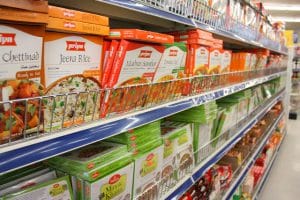Packaging Your Food Product: Tips For Food Manufacturers

Many first-time food manufacturers struggle with packaging their product, but the process doesn’t have to be daunting. Image source: Flickr user Leslie Seaton.
Being a food manufacturer is no easy feat, especially when you produce your first product. Basically, it’s just one thing after another. When you’ve finally perfected your food product, for instance, it’s time to get it packaged so you can get your product on store shelves as soon as possible.
Packaging your food product can be a difficult process for first-time food manufacturers to navigate. I often get questions about packaging, so I thought I would write down my best tips to help those of you who are getting ready to move into the packaging phase of your journey. My hope is that this advice demystifies the process a bit so you can navigate this next step of the food manufacturing process with ease.
Tip #1: Get a Non-Disclosure Agreement
Packaging your food product means you will be working with a number of people who will have access to your product and most of the information about it. In order to protect your business, it’s standard practice to get a non-disclosure agreement and have each of the other people you work with sign one. This way, they will not be able to share any information about your product with others.
Tip #2: Design Your Package
I know some food manufacturers who design their packages themselves, but most people hire a designer to help them make the packaging look as pleasing as possible. Designers, especially those with experience in the food industry, have a very good sense of what sells and that can make a huge difference in how well your product does—especially in the beginning when people haven’t yet tried it.
Looking online for a designer is your best bet, as you’ll be able to see samples of their work on their website. Once you’ve chosen the one you align with best, be sure you have all the information you need to be included on the package ready for them so they can incorporate it into the design. Here are the things you’ll need to have ready for your designer (or you, if you are doing the design yourself):
- Name of your product, as you’d like it to appear
- Nutrition facts panel
- Ingredient list
- Allergen statement(s)
- Health claims or nutrient content claims
- Name and address of manufacturer or distributor
You’ll also want to make sure your designer has a copy of the FDA’s labeling guidance so they know where each piece of information must appear on the package.
And if you haven’t yet made your nutrition facts panel, I suggest using an FDA-compliant online nutrition analysis software, like LabelCalc, to create one. Making your label only takes a few minutes and you can easily print or download it to share with your designer.
Tip #3: Find a Printer
Once you have your design finalized, it’s time to find a printer to produce your package. Typically, printers specialize in one or two types of packaging. Some, for instance, only print boxes, while others do plastic work. You definitely want to choose a printer who specializes in the type of packaging you want and who has a lot of experience with FDA regulations, as they will be familiar with the specific requirements.
Keep in mind that some companies are now providing all the services you need for packaging, including package printing, so you may want to search for one in your area.
Tip #4: Find a Co-Packer
Finding a good co-packer is a food manufacturer’s dream. Co-packers will either package your finished product for you or produce and package your product. They offer incredible value either way, as they will be very familiar with FDA and USDA regulations and therefore can ensure that everything is done according to industry standards.
Believe it or not, having a co-packer produce your product and package it for you can actually save you money. After all, you won’t have to worry about leasing a commercial kitchen space, renting food-grade production equipment, or hiring and paying employees. If it is your first product and budget is a concern, therefore, it may be a good idea to go with a co-packer.
Tip #5: Find a Laboratory That Tests for Safety
Once your product has been packaged, you will need to have it tested for safety. Be sure to choose a lab that specializes in food safety testing, as they will be familiar with the requirements and testing for your particular product. When your product has been tested and comes back safe, you’re ready to get your product on store shelves!
While packaging can certainly be a challenging part of the food manufacturing process, it doesn’t have to be that way. As long as you stay organized, remember your non-disclosure agreements, and do some thorough research to find other businesses to work with in your area, you shouldn’t have any issues. And once you’re finished packaging, you can finally start getting your product out there—and that is really the most important thing.
LabelCalc is an industry-leading online nutrition analysis software food manufacturers use to create FDA-compliant nutrition facts panels. To learn more or to start analyzing your product, contact us today.
